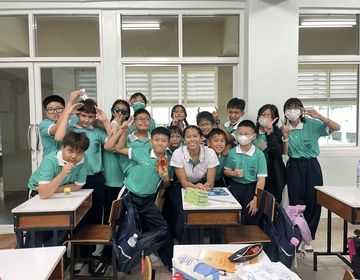Tips for Teaching Young Learners Online
Online teaching demands patience and ingenuity. It has required the reimagining of the classroom experience.
My school has been online for all but a few weeks of this semester, and at this point, I am beginning to wonder if I will see my students in-person again. I am hopeful that it will be safe for us to meet in the wonderland of school again soon, but for now, online is the best alternative.
For my students, mostly 4-5-year-olds, this is the beginning of their formal education, and this year will set the stage for the rest of their schooling. In kindergarten, students gain not only foundational speaking, numerical, and phonics knowledge but also learn crucial social and cooperation skills. Many of the classroom experiences that are pivotal to this development are impossible to replicate in an online format, but us teachers are doing our best to preserve the community of our classrooms and nurture a lifelong love of learning in our students as they are experiencing the fear, uncertainty, and change of another pandemic year.
Online learning presents a unique set of challenges for kindergarten. At this age, and especially considering the language barrier between my students and me, students need to move and interact. For the majority of my students, my classes are their introduction to English. I teach almost entirely in English and know that they understand and absorb only a small fraction of what I say. Because of this, I rely heavily on the interactive possibilities of the classroom. When language fails, I can demonstrate with full-body movements. I can arrange students into collaborative groups. When students are struggling to write the English letters, I can reposition the pencil in their hands and make dotted lines for them to trace. We play a lot of games, and I use a lot of realia. On Zoom, I am talking at them for the majority of a 40-minute class in a language that they do not understand.
In my efforts to make online learning both manageable and effective for kindergarteners, I have developed a model for my classes that I believe balances learning and support. Here are a few of my discoveries, which were made through trial and error and adjustment.
Maintain Routines
Routines are key. Consistency, especially during such irregularity, can offer some comfort. I begin my classes the same way each day, by asking a few questions, which we have practiced exhaustively and students can answer confidently in English, such as, “How are you?” Students know what to expect when they see me on the screen, and some have even begun asking me the same questions before I ask them. Attending a class in a foreign language can be overwhelming, so giving students tasks that they are familiar with and that they can accomplish builds their confidence and helps keep them from shutting down mid-lesson.
Song, Dance, and Body Movement
Whenever possible, I include song and dance in my lessons. There are numerous dance videos online that students love to follow along to. A bit of enjoyment helps maintain engagement, and the English lyrics help students retain vocab. When I see my students begin to lose focus, I have everyone stand up, and we move our bodies for a few minutes before continuing.
Incorporate Visuals
I have discovered that students learn best when they have something to look at. Though not the most entertaining of materials, I use flashcards frequently; they both provide a visual and require a student response. PowerPoints (with lots of pictures) make a useful teaching aid for vocabulary. Videos complimenting the lesson can also be useful. I have also used online learning games in my lessons, which encourage student participation. When applicable, I bring objects for students to examine, which at the very least, capture their attention.
Active Learning
As mentioned, the online format prevents many interactive learning activities. However, there are a few ways to get students engaged. Though not quite the same through a screen, science experiments are always a big hit. During our unit on rain and water, I showed a simulation of rainfall with blue ink and shaving cream clouds that had the kids amazed. I have also seen the homeroom teachers do various experiments with food coloring while online. Crafts are another way to get kids involved. Keeping in mind that students may not all have access to materials at home, I try to keep it simple. This week, we made Mother’s Day cards, which required nothing more than paper and colors.
Assigning Homework
I typically do not assign homework to kindergarten, but because we have spent so much time online, during which I do not see every student each day, I have needed a way to assess learning. Because many students do not attend online classes regularly, and even those who do often do not participate, it is important to monitor student learning. By assigning work for students to complete at home, I can make sure that students are practicing the skills we are learning in class. I don’t assign anything too time-consuming or anything that will require too much of parents. Examples including having students practice writing the letters of the alphabet or make a video in which they say English letters and phonics. Parents will then send photos or videos of the work for me to evaluate.
Managing Expectations
At the end of the day, these are just kids doing their best to learn a new language with limited learning resources and daily frustrations. As challenging as it is to teach online, I know that it must be so much harder for my students. Every day is different with new challenges and new victories. Sometimes, students break down in the middle of class and need to take a break. Some days, the internet is spotty, and we are disconnected five times. Other days, we are singing and dancing and making meaningful discoveries. It is important to remember that these children are doing their best, and that needs to be enough.
Related Posts
Why I’m Choosing to Get TEFL Certified After Teaching a Semester in Thailand
Why I Started Teaching Without a TEFL Certification When I decided to teach English in Thailand in the Spring of 2023, I was looking for a new adventure and a... keep reading
Rewriting My Top 10 Reasons: What a Year in Thailand Taught Me
Revisiting my First Blog Post If you scroll through my blog posts, you will find my first post: Why to Teach English in Thailand: My Top 10 Reasons. For anyone... keep reading
Exploring Thailand's Neighbors: Traveling To Laos and Cambodia
When I moved to Thailand, I knew that exploring Southeast Asia was high on my list of things to do. There were many places in Thailand I wanted to see... keep reading






